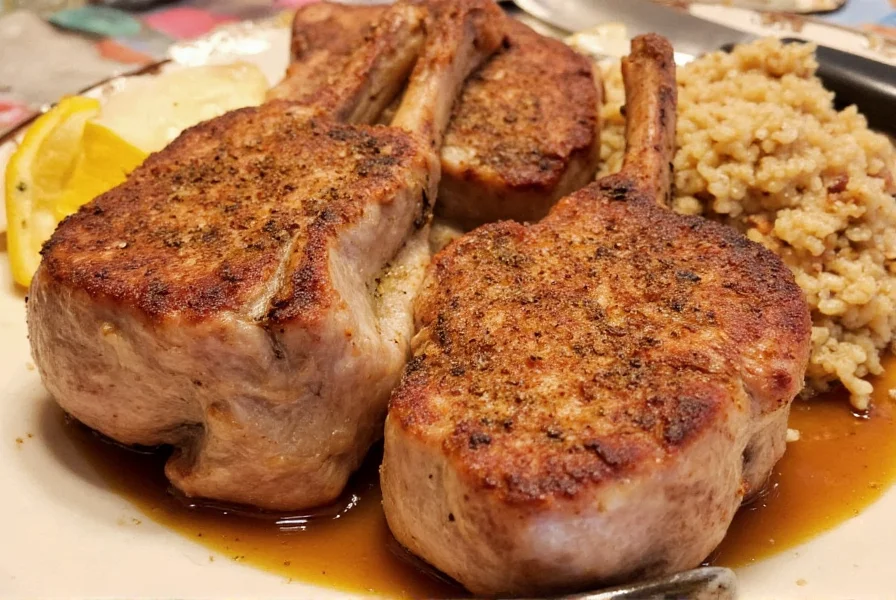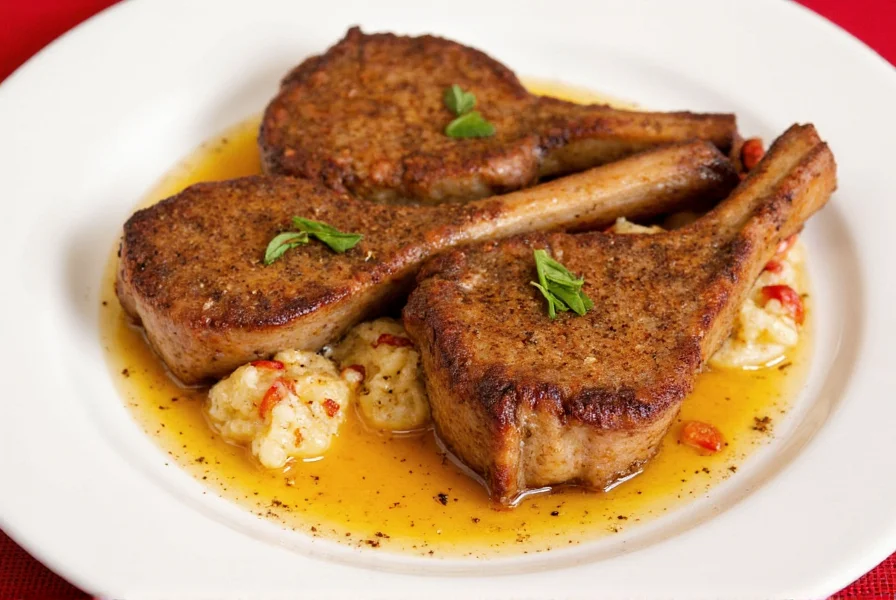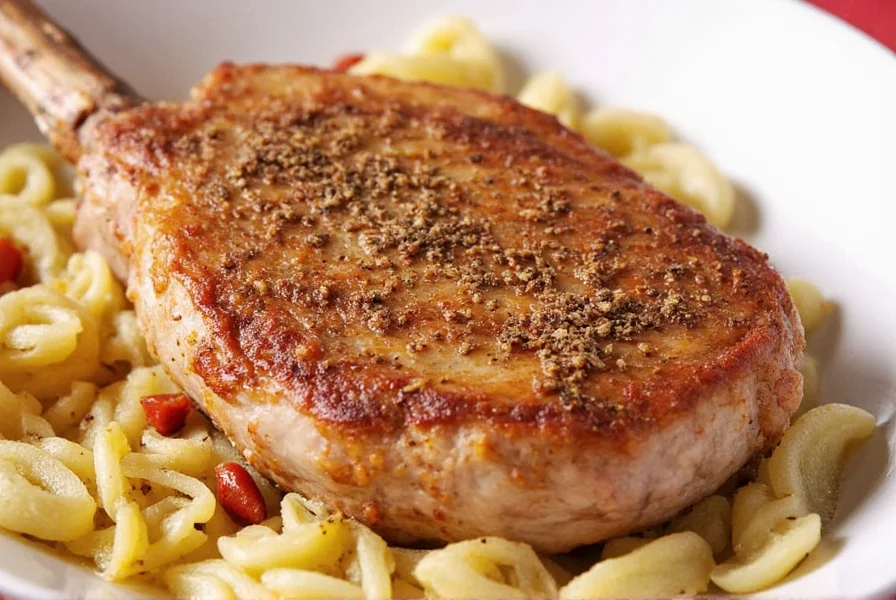Table of Contents
Italian Seasoning Pork Chops Recipe
Learn how to make juicy, flavorful pork chops with this easy Italian seasoning recipe. Perfect for weeknight dinners or special occasions.
- Prep time: 10 minutes
- Cook time: 20 minutes
- Total time: 30 minutes
- Servings: 4
Ingredients
- 4 bone-in pork chops (1 inch thick)
- 2 tablespoons Italian seasoning
- 1 tablespoon olive oil
- 1 teaspoon salt
- ½ teaspoon black pepper
- 2 cloves garlic, minced
Step-by-Step Instructions
- Preheat oven to 375°F (190°C).
- Pat pork chops dry with paper towels. Rub with olive oil, then sprinkle Italian seasoning, salt, and pepper evenly on both sides.
- Heat a skillet over medium-high heat. Sear pork chops for 2-3 minutes per side until golden brown.
- Transfer to a baking dish and bake for 12-15 minutes, or until internal temperature reaches 145°F (63°C).
- Let rest for 5 minutes before serving.
Practical Tips for Cooking Pork Chops with Italian Seasoning
Cooking pork chops with Italian seasoning doesn't have to be complicated. Here are some practical tips to make sure your dish turns out perfectly every time:
- Choose the Right Cut: Look for thick-cut pork chops (around 1 inch thick) to ensure they stay juicy and flavorful during cooking.
- Season Generously: Don't be shy with the seasoning. A good coating of Italian seasoning ensures every bite has that signature Mediterranean flavor.
- Use a Hot Pan: Searing the chops in a hot skillet helps lock in juices and create a nice crust.
- Let It Rest: After cooking, let the chops rest for a few minutes before serving. This allows the juices to redistribute and makes the meat more tender.
- Pair with Complementary Side Dishes: Think roasted vegetables, garlic mashed potatoes, or a fresh salad to balance out the richness of the pork.
Cooking Techniques That Elevate the Dish
There are several ways to cook pork chops with Italian seasoning, each bringing its own unique texture and flavor profile. Here are some popular methods:
- Searing and Baking: Start by searing the chops on the stovetop, then finish them in the oven for even cooking and a golden-brown crust.
- Grilling: Grilled pork chops with Italian seasoning offer a smoky, charred flavor that pairs well with summer barbecues.
- Slow Cooking: Use a slow cooker to infuse the meat with deep, rich flavors over several hours.
- Stir-Frying: For a quick and easy meal, stir-fry thin slices of pork with Italian seasoning and serve over rice or noodles.

Each method has its advantages, so choose the one that best fits your schedule and taste preferences. The key is to keep the seasoning consistent and bold.
Buying Guide: Choosing the Best Italian Seasoning
Not all Italian seasonings are created equal. When shopping for the right blend, consider the following factors:
- Ingredients: Check the label for natural herbs and spices like oregano, basil, and garlic. Avoid blends with excessive salt or artificial additives.
- Brand Reputation: Opt for well-known brands that prioritize quality and authenticity. Brands like McCormick, Mrs. Dash, and Simply Organic are reliable choices.
- Flavor Profile: Some blends are more herb-forward, while others have a stronger garlic or onion presence. Choose based on your personal preference.
- Usage: Consider whether you want a general-purpose seasoning or one tailored for specific dishes like pizza, pasta, or grilled meats.
If you're looking for a premium option, try an organic or artisanal Italian seasoning. These often have more complex flavor profiles and are ideal for those who want to elevate their cooking experience.
Comparison Table: Italian Seasoning Brands
| Brand | Key Ingredients | Flavor Profile | Best For | Price Range |
|---|---|---|---|---|
| McCormick | Oregano, Basil, Thyme, Garlic | Classic, balanced | General use, pasta, soups | $3–$5 |
| Simply Organic | Organic Oregano, Basil, Rosemary | Earthy, aromatic | Health-conscious cooks, grilled meats | $6–$8 |
| Mrs. Dash | Oregano, Parsley, Sage | Light, zesty | Low-sodium recipes, salads | $4–$6 |
| Bertolli | Oregano, Basil, Garlic, Onion | Rich, savory | Pizza, tomato-based dishes | $5–$7 |

This table can help you pick the perfect Italian seasoning for your next meal. Each brand has its strengths, so it's worth experimenting to find your favorite.
Frequently Asked Questions About Pork Chops with Italian Seasoning
How much Italian seasoning should I use on pork chops?
For best results, use about 1-2 teaspoons of Italian seasoning per pork chop (about 1 inch thick). If you're making a marinade, increase to 1-2 tablespoons per pound of pork. Remember that dried herbs are more concentrated than fresh, so adjust accordingly.
Should I marinate pork chops with Italian seasoning?
Yes, marinating enhances flavor penetration. For optimal results, marinate pork chops for 2-4 hours in the refrigerator. Avoid marinating for more than 8 hours as the acids in some seasoning blends can start to break down the meat texture.
What internal temperature should pork chops reach when cooked?
Pork chops should reach an internal temperature of 145°F (63°C), followed by a 3-minute rest period. This ensures they're safe to eat while remaining juicy and tender. Using a meat thermometer is highly recommended for accuracy.
How can I prevent my pork chops from drying out?
To prevent dryness: 1) Don't overcook (use a thermometer), 2) Choose bone-in chops which retain moisture better, 3) Let the meat rest for 5-10 minutes after cooking, 4) Consider brining before seasoning, and 5) Use a meat mallet to even out thickness for more uniform cooking.
Can I use fresh herbs instead of dried Italian seasoning?
Absolutely! Use three times the amount of fresh herbs compared to dried (since dried herbs are more concentrated). For example, if a recipe calls for 1 teaspoon dried Italian seasoning, use 3 teaspoons of fresh chopped herbs. Combine fresh oregano, basil, thyme, and rosemary for the best results.
Does Italian seasoning contain salt?
It depends on the brand. Some Italian seasoning blends include salt while others are salt-free. Always check the ingredients list if you're monitoring sodium intake. For more control over salt content, purchase salt-free Italian seasoning and add your own salt to taste.
What are the best side dishes to serve with Italian-seasoned pork chops?
Excellent pairings include roasted vegetables (especially zucchini, bell peppers, and cherry tomatoes), garlic mashed potatoes, risotto, or a simple arugula salad with lemon vinaigrette. For a complete Italian-inspired meal, serve with pasta and a tomato-based sauce.
Can I use Italian seasoning with other meats besides pork?
Definitely! Italian seasoning works wonderfully with chicken, beef, lamb, and even fish. It's also excellent for vegetables, soups, sauces, and salad dressings. Its versatility makes it a staple in any well-equipped kitchen.
Conclusion
Mastering the art of cooking pork chops with Italian seasoning opens up a world of flavor possibilities. This simple recipe delivers restaurant-quality results with minimal effort.
From choosing the right cut of meat to selecting the best seasoning, every step contributes to a delicious outcome. With the right techniques and a little bit of creativity, you can turn ordinary pork chops into an extraordinary meal.
So, grab your favorite Italian seasoning, preheat the pan, and get ready to enjoy a dish that's as satisfying as it is flavorful. And remember—sometimes the simplest ingredients can make the biggest impact.
A sentence that expands on the pork chops with Italian seasoning: The combination of tender pork chops and a fragrant blend of Italian seasoning creates a symphony of flavors that brings the warmth of a Mediterranean kitchen straight to your plate.











 浙公网安备
33010002000092号
浙公网安备
33010002000092号 浙B2-20120091-4
浙B2-20120091-4